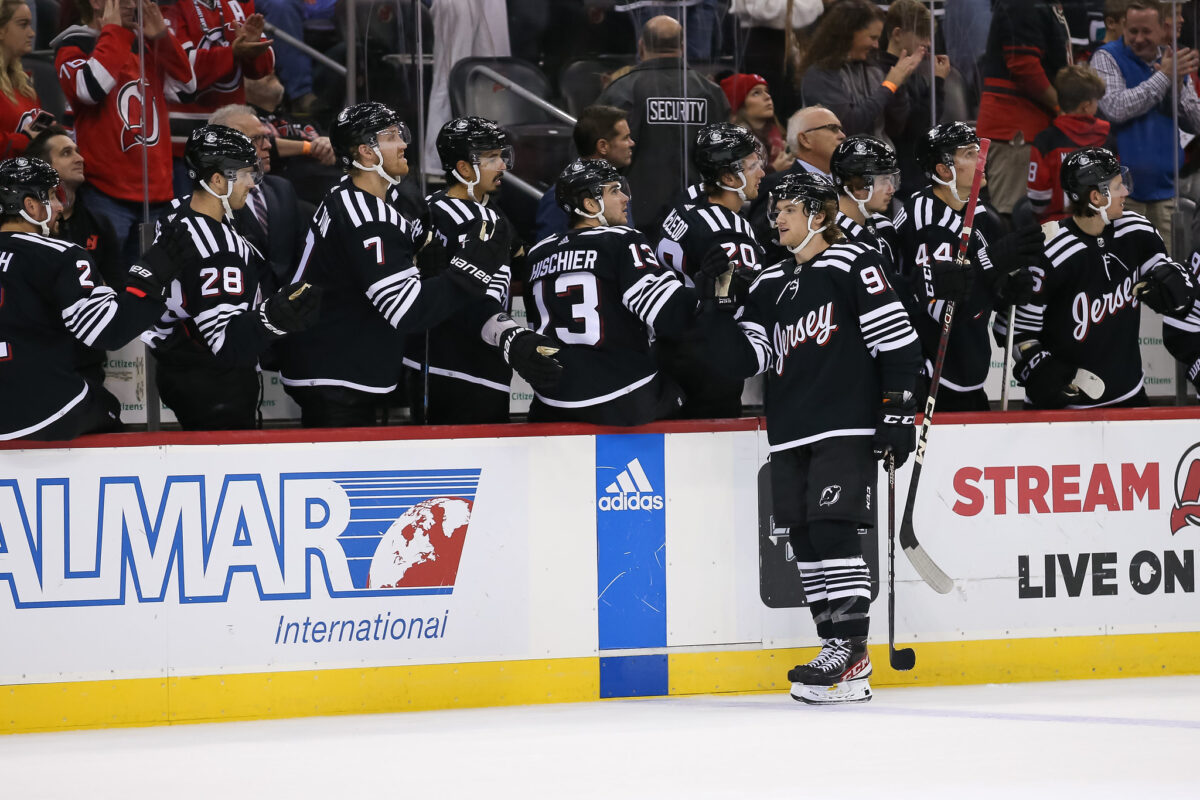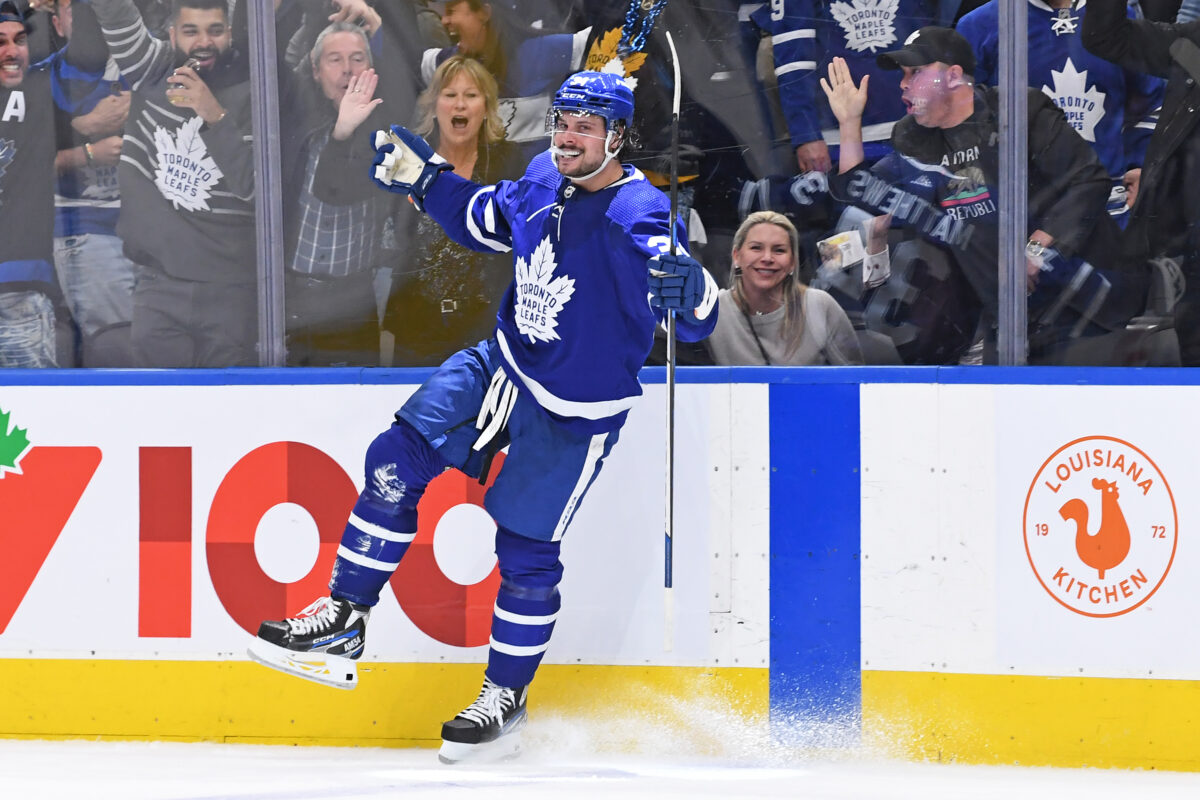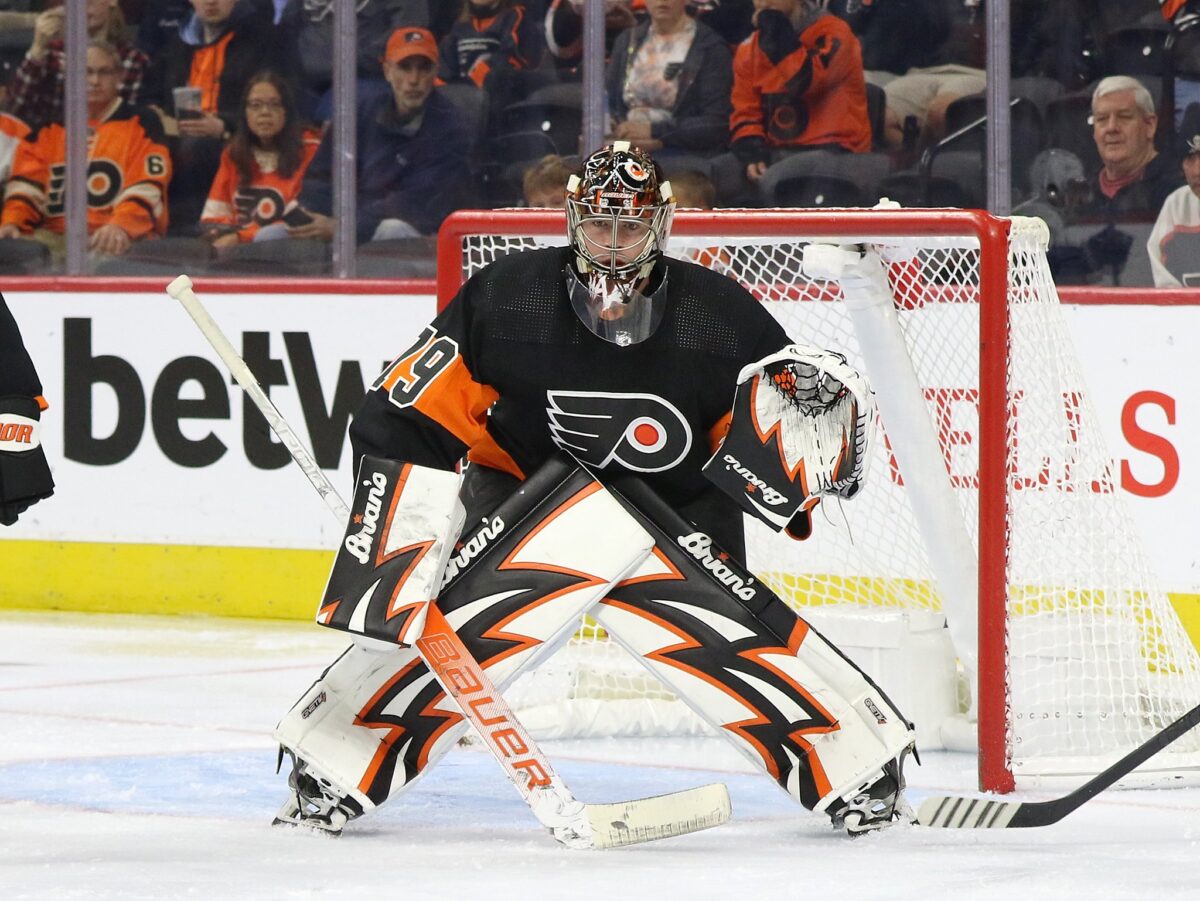Welcome to the first edition of the 2022-23 NHL Analytics Report, a weekly roundup of the latest trends and a collection of statistical observations from around the league. Given that the season is nearly a month old, the inaugural report will focus on the broader storylines at the forefront before transitioning into more specific observations in later editions.
An important caveat to start: the sample sizes are still tiny in the grand scheme of things, and it’s foolish to make sweeping declarations even after each team has played 10 games or more (save for the St. Louis Blues). Players on unexpected hot streaks will eventually slow down and snakebitten scorers should find the twine with more regularity before long. This series aims to make you, the reader, aware of which developments may be a mirage, and which may be closer to reality. With that, here are five observations from the first few weeks of the 2022-23 NHL season.
Devils Emerging as Stanley Cup Contenders
For those who knew where to look, the New Jersey Devils‘ rapid evolution into legitimate Stanley Cup contention doesn’t come as much of a surprise. They were a decent possession team at 5v5 during the 2021-22 season despite icing the youngest lineup in the league (their average age was 25.8 years old). They ranked sixth in their share of high-danger chances (HDCF%), 11th in scoring chances (SCF%), 13th in expected goals (xGF%), and 14th in shots (SF%).

Possession and chance quality numbers are only one piece of the puzzle, however, as finishing and goaltending are just as much of a factor in a team’s championship aspirations. The 2021-22 Devils were sunk by abysmal goaltending as a carousel of netminders contributed to an .881 team save percentage (SV%) – 31st in the league last season – and had all five goaltenders who suited up ranked within the bottom 30 of goals saved above expected (GSAx) according to MoneyPuck. Any way you put it, they were awful.
Elite goaltending can mask a weak team in front of the crease while above-average conversion can help overcome a lack of volume in the shot or scoring chance department. It’s rare that Stanley Cup winners have all three, but very few can win a title without accounting for two of the three criteria on their checklist.
It’s also true that any team with multiple first-overall picks (Jack Hughes and Nico Hischier) is on the fast track to contention but as many have demonstrated (namely the Edmonton Oilers and the Buffalo Sabres of the early 2010s), that’s hardly a guarantee for success. What’s evident is that all of the ingredients seem to have come together this season, leading to an early lead in the Metropolitan Division while still being the 29th-youngest team in the NHL.
The Devils currently rank first in each of the aforementioned shot and scoring chance categories, but are finally getting the finishing luck and capable (to an extent) goaltending needed to capitalize on their sparkling 5v5 results. Their stars are producing at an elite rate, and their netminders have managed to scrounge up the 21st-best SV%. They could still stand to improve in the crease, but they’ve seen enough progress that their record reflects their on-ice dominance. Expect the Devils and their key contributors to feature heavily in future editions of this report – these guys are for real.
Maple Leafs’ Matthews Mired in Early Slump…for Now
When you become the first NHL skater in a decade to score 60 goals in a single season, future expectations are often set extremely high. Auston Matthews‘ (relatively) slow start to the season has come in under those lofty expectations, but his underlying numbers suggest that the subpar conversion rate shouldn’t persist for much longer.
According to Natural Stat Trick, the Maple Leafs’ star pivot ranks fourth in the NHL in shots and individual expected goals (ixGF), and first in individual scoring chances (iSCF) in all situations. Although the traditional boxscore stats haven’t been as favourable to him (he sits six goals off of Connor McDavid’s 12 for the league lead), it isn’t for a lack of trying. It bears reminding everyone that at this point last season, Matthews only scored five goals in nine games but ended up outscoring his nearest competitor (Leon Draisaitl) by five goals, despite playing seven fewer games than the Edmonton Oilers’ superstar.

Labeling Matthews’ 41-goal 82-game scoring rate as a slump would have been more accurate had I written this a week ago, but that only goes to show how high he has set the bar so far in his career. Since making his NHL debut in 2016-17, the American-born center leads all skaters in goals at even-strength (198) and in all situations (265), edging out an all-time great in Alexander Ovechkin in both departments. If you can count on anyone to put the puck in the net, it’s Matthews, and it shouldn’t be long before he’s creeping up on McDavid in the Rocket Richard Trophy race.
Sabres’ Dahlin Delivering On First-Overall Potential
Young defensemen have a notoriously steep learning curve when it comes to adjusting to the NHL and Rasmus Dahlin, the Buffalo Sabres’ first-overall selection in the 2018 NHL Draft is no exception. Partially due to inexperience and a thin supporting cast, Dahlin failed to approach the heights dictated by his draft pedigree. Fortunately for the Sabres’ future fortunes, those early-career struggles appear to be an afterthought in what has been an (early) Norris Trophy-caliber season so far.
Among all defensemen this season, Dahlin is tied for fourth in assists (eight), but ranks second in goals (seven), points (15), and shots (44), trailing only his countryman Erik Karlsson in the latter three categories. He also ranks first in ixG and high-danger chances, showing that his goalscoring prowess (although a tad high at just under 16% shooting) is due to skill and getting into dangerous areas rather than unsustainable luck.
You May Also Like:
- Anaheim Ducks’ Surprises and Areas for Improvement at 30-Game Mark
- Blues Prospects Selected for the 2025 World Juniors
- Maple Leafs News & Rumors: Nylander, Matthews, Marner & Woll
- Hurricanes End December With Critical Stretch of Games
- Wild Need to Play “Full Team Game” to Get Through Injuries
Offense is only one half of the equation and he’s never had significant trouble putting up points in the past, but his play on the defensive side of the puck is a big reason why he and the Sabres are two points from an automatic playoff slot. Fellow franchise cornerstone Owen Power leads the team in average 5v5 ice time, but Dahlin sits 12th among all NHL defensemen at just under 19 minutes a game. Despite taking on a heavy workload, the 22-year-old blueliner has a significantly positive impact on the team’s ability to drive play in the right direction. When Dahlin takes the ice at 5v5, the Sabres account for 55.5% of SF, 54.1% of xGF, and 56.4% of SCF, stout numbers for a still-developing lead defender.
Time will tell if Dahlin and the Sabres can continue to make an attempt at securing their first playoff spot since 2011, but the Swedish rearguard looks to have broken into the upper echelon of NHL blueliners. For a long-suffering fanbase, that alone is enough of a positive development, and the organization finally looks to be back on the path of contention.
Resurgent Hart Masking Flyers’ Warts
An early trend rippling through the NHL is that several basement-dwellers have made surprise starts to the 2022-23 campaign, with the Philadelphia Flyers acting as the unexpected leader of the pack in this regard. Their 6-3-2 record through 11 games represents a .636 points percentage (PTS%), good for fifth in the Eastern Conference. Their offence has been non-existent (31st in goals scored) but they also rank 29th in goals against, mostly due to the resurgence of 24-year-old goaltender Carter Hart. Let’s first contextualize the quality of chances and the volume of his workload.
The Flyers are one of the worst defensive teams at 5v5 in front of Hart, ranking 29th in shot-share, 31st in terms of their share of expected goals and high-danger looks, and dead last in their claim of overall scoring chances. They also rank at or near the bottom in terms of shots and chances allowed per-60-minutes, struggling to do anything of substance with or without the puck. Simply put, the ice is heavily tilted in favour of the Flyers’ opponents on a nightly basis, forcing Hart to stand on his head for them to have a chance to win.

Among goalies to have played in at least two games this season, Hart ranks third in SV% (.946) and first in high-danger SV% (.966) and GSAx (17.02). In fact, he’s saved around 5.5 more goals than Connor Hellebuyck in second place, which is also the difference between second and Darcy Kuemper in ninth. Other goalies have gotten off to very strong starts, but none have come close to matching Hart’s impact thus far.
I hate to rain on anyone’s parade, but fans should temper their expectations even after witnessing the Flyers shoot out into a playoff spot in the early going. The group in front of Hart is nowhere near the calibre suggested by their record, but the blossoming netminder’s performance is reassuring, especially after two years in the wilderness. It’s only a matter of time before his numbers regress closer to his career average, at which point the team’s defensive warts will begin to show, and their quality (or lack thereof) becomes readily apparent.
Even still, seeing Hart’s return to prominence is a promising sign for the future, and he could work his way into a Vezina Trophy nomination if he manages to maintain his superhuman form all season. Rejoice Flyers fans, for your franchise goaltender has returned, even if it jeopardizes your chances to win the Connor Bedard sweepstakes.
Avalanche Power Play Firing at Historic Pace
Let’s close out the first edition of this series with a trend that should surprise no one. Through 11 games, the Colorado Avalanche‘s power play has been unstoppable. Please, stop me if you’ve heard that before. Using traditional modes of analysis (like raw conversion percentage), the Avalanche have been historically dominant.
If the season ended today, the Avalanche’s 38.2% powerplay would be the most efficient strike-rate since the Montreal Canadiens forced the league to adopt the modern system which ends powerplays as soon as a goal is scored. It should be noted that the Edmonton Oilers (31.9%), Vancouver Canucks (30.2%), Dallas Stars (29.3%), and Arizona Coyotes (29%) currently boast conversion rates that would rank within the top-12 in NHL history. Odds are one or more drop off their current pace, but that should serve as a reminder that the season is still young and results drawn from small sample sizes can be misleading.

The Avalanche are still generating a high quality of chances with the man-advantage, although their rate of expected goals for per-60-minutes is only their third-highest clip since the stat began to be recorded in 2007-08. What sets them apart from other units is their unique collection of finishing talent, including the likes of Cale Makar, Mikko Rantanen, and Nathan MacKinnon, who rank third, fifth, and 11th respectively in powerplay points over the past three seasons. The operation spearheaded by the Oilers’ dynamic duo is the only group that looks capable of giving the Avalanche a run for their money, but even they haven’t matched Colorado’s buzzsaw of a powerplay.
Like most Stanley Cup champions in the salary cap era, the Avalanche saw their roster depth erode as free agents tested the market and gave their stars – namely MacKinnon – massive raises of their own. Even so, they’ve stemmed the bleeding well enough to climb back into contention for the Central Division crown. When a team’s special teams are running as hot as Colorado’s has through the first month of the season, there is a much wider margin for error at even strength or on the penalty kill. Beware the Avalanche power play – no one’s had an answer for it yet.
Will These Early NHL Trends Continue?
As I stated in the introduction, the season is nearly a month old, and making any definitive statements about a team or individual’s fate is tricky. That’s not to say they won’t end up coming true, but some caution is warranted. Tune in next week for another edition of the 2022-23 NHL Analytics Report.
Data courtesy of Evolving Hockey, MoneyPuck, Natural Stat Trick, and the NHL.